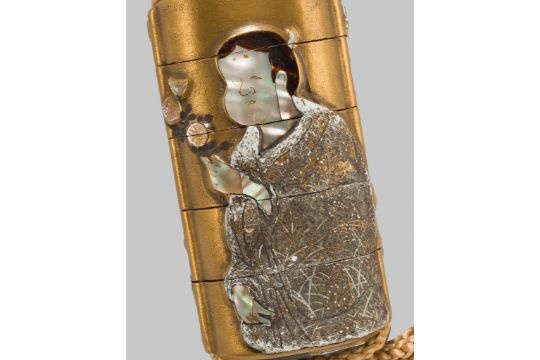KORIN: A MITSUDA INLAID FOUR-CASE GOLD LACQUER INRO WITH OTAFUKU
KORIN: A MITSUDA INLAID FOUR-CASE GOLD LACQUER INRO WITH OTAFUKU
After Ogata Korin (1658-1716), signed Korin zo 光琳造 and sealed Hoshuku 方祝
Japan, 18th-19th century, Edo period (1615-1868)
Of upright rounded form and oval section, bearing a fine kinji ground, inlaid in mitsuda (pewter) and aogai, to depict to the front Otafuku admiring a sprig of chrysanthemum, her mitsuda-inlaid cloak detailed with gold hiramaki-e grasses and butterflies. The verso decorated with a lush branch of large, blooming chrysanthemum blossoms. Signed to the underside KORIN zo [made by Korin] and with a pewter-inlaid seal Hoshuku. The interior compartments of nashiji with gold fundame rims. With a bamboo netsuke in the form of a mokugyo bell.
HEIGHT 9.8 cm, LENGTH 5 cm
Condition: Good condition with wear and typical losses and associated repairs to the pewter inlays. Some soiling to the verso and traces of use to the interior compartments.
Provenance: From a private collection in Manhattan, New York, United States of America. An old collector's label to the interior, '422.YHO.Q 140. Korin style. X C - Vi'.
Rinpa is a modern term that refers to a distinctive style of Japanese pictorial and applied arts that arose in the early seventeenth century and has continued through modern times. Literally meaning 'school of Korin,' Rinpa derives its name from Ogata Korin (1658–1716), a celebrated painter from Kyoto. It embraces art marked by a bold, graphic abbreviation of natural motifs, frequent reference to traditional court literature and poetry, the lavish use of expensive mineral and metallic pigments, incorporation of calligraphy into painting compositions, and innovative experimentation with new brush techniques. Transmitted by means of pattern books and manuals, the work of the Ogata Korin inspired numerous other craftsmen.
Korin was a follower and the greatest exponent of the versatile artist and craftsman, Hon'ami Koetsu (1558-1637). Koetsu pioneered a distinctive style of lacquerwork that made use of relatively straightforward techniques of lacquer, with inlays of shell and lead. His designs are usually in silhouette with little or no interior detail.
Bid on this lot
Estimate
Reserve
Time, Location
Auction House
KORIN: A MITSUDA INLAID FOUR-CASE GOLD LACQUER INRO WITH OTAFUKU
After Ogata Korin (1658-1716), signed Korin zo 光琳造 and sealed Hoshuku 方祝
Japan, 18th-19th century, Edo period (1615-1868)
Of upright rounded form and oval section, bearing a fine kinji ground, inlaid in mitsuda (pewter) and aogai, to depict to the front Otafuku admiring a sprig of chrysanthemum, her mitsuda-inlaid cloak detailed with gold hiramaki-e grasses and butterflies. The verso decorated with a lush branch of large, blooming chrysanthemum blossoms. Signed to the underside KORIN zo [made by Korin] and with a pewter-inlaid seal Hoshuku. The interior compartments of nashiji with gold fundame rims. With a bamboo netsuke in the form of a mokugyo bell.
HEIGHT 9.8 cm, LENGTH 5 cm
Condition: Good condition with wear and typical losses and associated repairs to the pewter inlays. Some soiling to the verso and traces of use to the interior compartments.
Provenance: From a private collection in Manhattan, New York, United States of America. An old collector's label to the interior, '422.YHO.Q 140. Korin style. X C - Vi'.
Rinpa is a modern term that refers to a distinctive style of Japanese pictorial and applied arts that arose in the early seventeenth century and has continued through modern times. Literally meaning 'school of Korin,' Rinpa derives its name from Ogata Korin (1658–1716), a celebrated painter from Kyoto. It embraces art marked by a bold, graphic abbreviation of natural motifs, frequent reference to traditional court literature and poetry, the lavish use of expensive mineral and metallic pigments, incorporation of calligraphy into painting compositions, and innovative experimentation with new brush techniques. Transmitted by means of pattern books and manuals, the work of the Ogata Korin inspired numerous other craftsmen.
Korin was a follower and the greatest exponent of the versatile artist and craftsman, Hon'ami Koetsu (1558-1637). Koetsu pioneered a distinctive style of lacquerwork that made use of relatively straightforward techniques of lacquer, with inlays of shell and lead. His designs are usually in silhouette with little or no interior detail.



